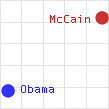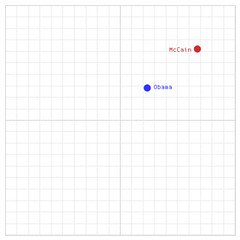A friend recently commented on how our country is politically polarized. Yes, I feel that — but I also feel that many of us are apathetic and alienated from the political process.
How could these both be true? It seems contradictory, paradoxical.
Perhaps the answer, or part of it, has to do with our narrowly circumscribed political dialog. I’ve been puzzling over how to better express the idea.
Say you’re looking at two marks on a wall. If you’re standing very close, with your nose practically touching the plaster, you will see the two marks as rather far apart. But if you stand back and look at the whole wall, you might say that that the marks are quite close together.
Or take a bar graph. It’s a well-known fact that if you chop off the bottom of a bar graph you can exaggerate differences and make them seem bigger. There’s a whole chapter on this in How to Lie with Statistics.
Or say you listened to nothing but grandpa’s record collection. You might think dixieland and bebop represented the absolute opposite ends of the musical spectrum. And you’d be right, insofar as 1940s jazz was concerned.
All of these seem like variations on the same phenomenon. This has surely been observed and documented by those who study human cognition. What’s vexing me is I can’t think of the name for it. The only term I’ve encountered that seems to make sense is “truncated scale,” but that’s hardly ubiquitous.
Anyway, my theory is that some of us are “zoomed in” on two marks on the wall.
From this close view, the differences are vast and passions run high. There is a sense of polarization between these two diametrically opposed points.
But if we’re zoomed out, we see a contested area that seems to be only a small part of the whole map. From this perspective, the rhetoric of the campaigns can seem overheated and alienating — a tempest in a teapot.
Note that both views are valid to some extent. Sometimes you have to zoom in to see important details. My inclination is to take the wider view; that’s just who I am. That doesn’t necessarily mean this view is more correct or relevant. But as the saying goes, “Distance lends perspective to the view.”
Discover more from b.rox
Subscribe to get the latest posts sent to your email.


Historically in the US the difference between the two major parties has been less than in almost any other major country.
Certainly Conservatives and Labor in the UK were much further apart. less so since Tony Blair, but before that it was a gap as wide as the grand canyon.
In the US differences tend to be about methods than outcomes.
Skepticism aside you have to still admit that we currently live in politically exciting times…
http://www.economist.com/displaystory.cfm?story_id=12470555
If only more of us had your perspective.
This election, in particular, seems to be making rabid hyenas of everyone. Driving me crazy.
Does that graph have any particular significance or was it just used for the point?
B,
I think your point is a valid one.
My original point, though, was to speculate that, once in a two-party system, the first party to set the agenda that demonizes their opposition would have, at least in the short term, a strategic advantage. I think that strategy describes the GOP over the last 40 years.
Where did you make *that* point? Certainly not in the post B linked to. And what is your evidence?
It’s an awfully simplistic view of politics that ascribes malice as the most powerful factor. I mean, *Mondale*? Really? *Dukakis*? This is the *best* the Dems could come up with? Only a simpleton could assert that some GOP-agenda-setting-machine hindered these otherwise powerful and compelling candidates. Even John Kerry was a sh*tty candidate.
Bullet: I was indeed only trying to make my point with the graphs, bu the points are not plotted randomly. They are based on the charts posted at the Political Compass. For their version, see:
http://www.politicalcompass.org/uselection2008
David: I think your original point was about the power dynamics in a winner-take-all system. In any case, I have gone off on a wild tangent.
Garvey: Um, oh, well, you’re really not talking to me at all, are you? You’re talking to David. I would love to think that this blog has become a place where two guys like you could find some common ground. But somehow I don’t think that’s gonna happen.
B,
You’re right. In my latest comment, I was expanding on my thoughts in my final sentence.
Sorry, B. I do agree with your idea that the two candidates are pretty much the same when you pull back a bit. It’s been that way for many election cycles, IMO. I, however, believe that the US has been shifting leftward for quite a while, esp. during the last 8 years. In all seriousness, Bush is to the left of Clinton. He ran as a leftist (“compassionate conservative”). The last intelligent politician worth a damn was Barry Goldwater of 1964. “The Conscience of a Conservative” is a book everyone should read.
I read something interesting the other day (wish I could remember exactly what, so I could link to it). It was explaining the dangers of having a high-minded do-gooder at the watch. I can’t really do it justice, but the upshot was that toiling for the do-gooder will be ceaseless, b/c the do-gooder always thinks he knows what’s best for you and wants to force you into that. And that’s precisely why even a Barack Obama lives above the X-axis in the diagram you posted. There is an authoritarian streak in the elitist left that makes them just like any other authoritarian (if not worse, b/c of the sheep’s clothing). That’s where the rubber of your truncate scale notion hits the road for me.
The world is littered with do-gooders, like Thomas Friedman who “wished we could be China for a day.” Ugh. That’s Machiavellian scheming at its worst: his massive brain has prescribed a solution for the rest of us moe-rons, and the only thing hindering its implementation is that old bugaboo, a free society. Talk about the ends justifying the means. And that’s what the American left is.